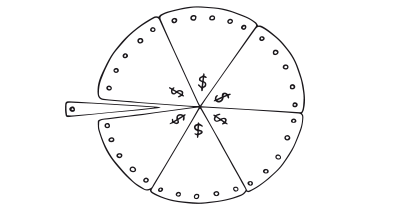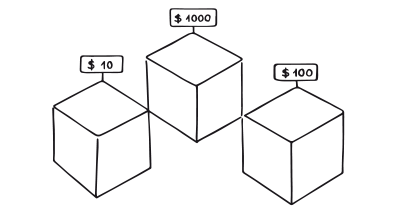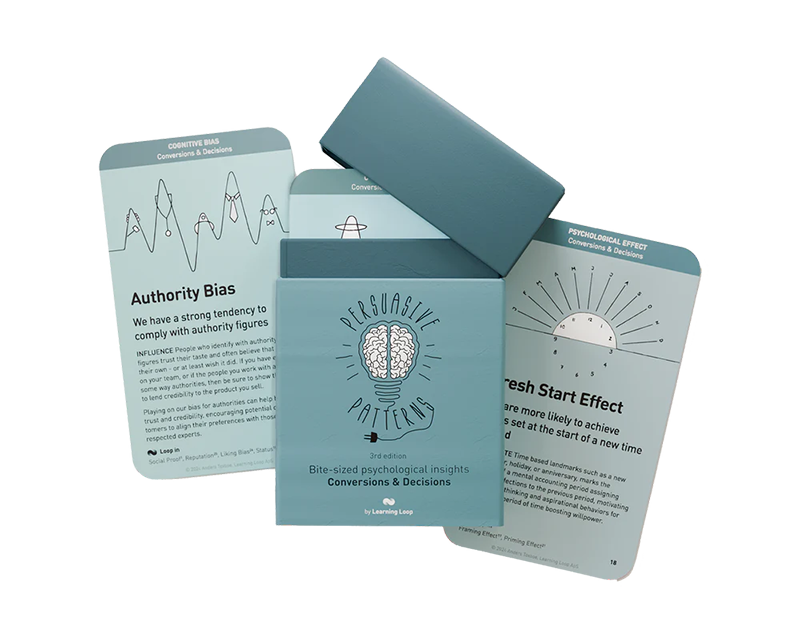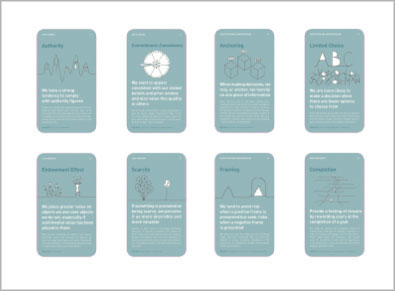Persuasive Patterns: Demonstration
Storytelling
We engage, understand, and remember narratives better than facts alone

Storytelling is the technique of using narrative structure to engage and influence an audience’s thoughts and actions. This approach leverages the natural human tendency to relate to stories better than to abstract facts or disjointed information. A narrative resonates with listeners or viewers by tapping into their emotions and values to motivate understanding, recall, and action. This technique is especially effective because narratives can simplify complexities, create connections, and foster a sense of community and shared values among diverse audiences.
Imagine a parent trying to teach their child the importance of honesty. Instead of lecturing the child on ethical principles, the parent tells a story of two friends where one lies and loses the trust of the other. Through the narrative, the child sees the consequences of dishonesty unfold, leading to a lost friendship. The story encapsulates the value of honesty in a relatable way, making the abstract concept of trust tangible and understandable to the child. This method engages the child’s emotions and imagination, helping them internalize the lesson more effectively than through direct instruction alone.
Bridging from the personal narrative, consider a digital marketing campaign by a company promoting eco-friendly products. Instead of presenting dry statistics about pollution and environmental decay, the company crafts a story. It details a young family’s journey toward a greener lifestyle, highlighting the challenges they face and the simple changes they make, such as using the company’s products. This narrative makes the concept of eco-friendly living relatable and achievable, illustrating the positive impact of individual actions on the environment.
By connecting the brand with a story that viewers can see themselves in, the campaign not only educates but also motivates change, effectively increasing customer engagement and boosting sales. Like the child learning from a personal story, the audience learns from the family’s journey, leading to a deeper understanding and appreciation of sustainable living.
The study
One of the seminal studies that illuminated the power of storytelling in persuasion is the work done by Melanie Green and Timothy Brock in their exploration of the “transportation-imagery model.” Their research shows how individuals become “transported” into a narrative world. When people read or listen to stories, they are often transported into the narrative – a psychological engagement that leads to high involvement in the story. This transportation does not just increase attention – it also enhances empathy, reduces counterarguing, and often results in readers or listeners embracing the beliefs and behaviors depicted in the narrative. This study is pivotal because it shows how effective storytelling can captivate and influence the audience by engaging them on a deep emotional level, making them more receptive to the message being conveyed.
Green, M. C., & Brock, T. C. (2000). The role of transportation in the persuasiveness of public narratives. Journal of Personality and Social Psychology, 79(5), 701-721.
The primary psychological principle underpinning the persuasive pattern of storytelling is known as “narrative transportation.” This theory posits that when individuals engage with a narrative, they are mentally transported into the story’s world, which diminishes their awareness of their immediate surroundings and increases their emotional investment in the narrative outcomes. This transportation leads to a greater likelihood of accepting the messages conveyed within the story due to reduced psychological resistance.
The immersive nature of narrative transportation allows the story’s morals, lessons, or branded messages to resonate more deeply with the audience, fostering a sense of connection and empathy towards characters and scenarios that parallel real-life decisions and actions. This principle effectively explains why individuals might change their attitudes or behaviors after being exposed to a persuasive narrative, as they align their beliefs and actions with those endorsed within the narrative framework.
By crafting narratives that involve relatable characters, conflicts, and resolutions, storytellers can tap into the audience’s emotions, making the experience memorable and impactful. This emotional connection is often argued to be more influential in changing beliefs and behaviors than the presentation of factual data alone.
Stories structure information in a way that makes it more accessible cognitively. A well-told story contains a clear beginning, middle, and end, which helps listeners organize and recall information efficiently. This narrative structure mirrors the way humans naturally recount events and experiences, making complex information easier to digest and remember.
It is a powerful method for conveying moral and ethical considerations. Through narrative, complex ethical dilemmas can be presented in a manner that encourages listeners to empathize with the characters and to consider the consequences of different actions. This can be a subtle yet profound way to influence audience attitudes and promote societal values.
The concept of narrative transportation, where the audience becomes so absorbed in the story that they are “transported” into its world, plays a central role in persuasive storytelling. This immersion reduces counter-arguing, increases persuasion, and can lead to stronger alignment with the values and behaviors promoted through the story.
Designing products with Storytelling
Put effort into understanding the core message or value proposition of your product and think of how a story can embody these aspects. The narrative should be relatable and evoke emotions that align with your brand’s values. Use customer journeys to map out potential storylines, considering key interactions where a story can naturally introduce or explain a feature. Visual storytelling elements like images, videos, and infographics can help convey the story more effectively, making it not only memorable but also easier to digest.
Focus on creating a seamless integration with the user experience by embedding narrative elements at key points in the user journey where they can naturally enhance the user’s interaction with the product. For example, during the onboarding process, use storytelling to illustrate how the product solves common problems or enhances the user’s lifestyle, making the benefits vivid and clear.
Try to not overburden users with a high cognitive load to process. Keep the story simple and focused. Avoid overcomplicating the narrative, which can distract or confuse users. The story should be easy to follow and should lead the user to a clear understanding of the product’s value.
Finally, always include a clear call to action. The story should naturally lead users towards taking a specific action, whether it’s purchasing a product, signing up for a service, or another key performance indicator for your product. This helps to ensure that the storytelling not only captivates but also converts.
Ethical recommendations
The persuasive power of storytelling, while effective, carries with it the potential for misuse. Stories can manipulate emotions and distort reality, leading users to make decisions that may not be in their best interest.
Marketing narratives might play on fears or insecurities to sell products, or political stories may oversimplify complex issues, influencing public opinion based on skewed or incomplete information. Additionally, storytelling can create echo chambers in digital media, reinforcing biases and reducing exposure to diverse perspectives. When used irresponsibly, storytelling can thus mislead, manipulate, and even harm the audience it seeks to engage.
To ensure that storytelling is used ethically and remains user-centric, several best practices should be followed:
- Transparency
Be clear about the intent behind the story. Audiences should be made aware of any persuasive aims or commercial interests tied to the narrative. This helps maintain trust and allows users to make informed decisions about how they engage with the content. - Accuracy
Ensure that stories, while persuasive, are based on accurate and verifiable information. Avoid embellishing facts or omitting key details that could mislead the audience. - Respect for the audience
Craft stories that respect the intelligence and dignity of the audience. Avoid using narratives that exploit vulnerabilities or insecurities. - Diversity and inclusion
Include a range of perspectives in storytelling efforts to avoid perpetuating stereotypes or biases. This not only enriches the narrative but also promotes a more inclusive approach that resonates with a broader audience. - Regular review and adjustment
Continuously review storytelling practices to ensure they align with ethical standards and respond to evolving audience expectations and societal norms.
Real life Storytelling examples
Spotify
Uses data-driven stories at the end of each year to give users a “Wrapped” summary of their listening habits, creating a personalized story that users often share on social media.
Airbnb
Uses storytelling to share real experiences of hosts and guests, highlighting the adventure and personal connections made through their service.
Nike
Creates advertising campaigns that tell stories of athletes who overcome adversity, embodying their slogan “Just Do It” and inspiring customers to pursue their own sports endeavors.
Trigger Questions
- What core value or message do we want our story to convey?
- How can we make our story relatable and emotionally engaging for our target audience?
- Are there clear, natural points in the user journey where integrating a story could enhance understanding or engagement?
- Do our stories reflect the values and expectations of our brand and our users?
- What visual or multimedia elements could we use to enhance the storytelling impact?
- How do we measure the effectiveness of our stories in engaging users and achieving our design objectives?
Pairings
Storytelling + Social Proof
Using narratives that feature real-life testimonials or success stories leverages social proof, reinforcing the message through relatable examples. This combination can be particularly effective in marketing campaigns where user stories validate the benefits of a product or service.

We engage, understand, and remember narratives better than facts alone

We assume the actions of others in new or unfamiliar situations
Storytelling + Framing Effect
By framing the narrative around specific values or emotions, storytelling can guide the audience’s perception and decision-making process. For example, framing a story around the joys of family life can effectively market a home security system.

We engage, understand, and remember narratives better than facts alone

The way a fact is presented greatly alters our judgment and decisions
Storytelling + Rewards
Integrating rewards into a narrative can motivate continued engagement. For instance, in an educational app, completing chapters of a story-based learning module could unlock badges or points, thereby combining the intrinsic appeal of the story with the extrinsic motivation of rewards.

We engage, understand, and remember narratives better than facts alone

Use rewards to encourage continuation of wanted behavior
Storytelling + Halo Effect
When a story is associated with a well-respected brand or celebrity, the halo effect can make the narrative more persuasive. The endorsement embedded within the story adds an additional layer of credibility and appeal.

We engage, understand, and remember narratives better than facts alone

We let impressions created in one area influence opinions in another area
Storytelling + Peak-End Rule
Designing stories so that they have a memorable peak and a strong, positive finish can significantly impact how users recall and evaluate their experience, making it a powerful tool for creating lasting brand impressions.

We engage, understand, and remember narratives better than facts alone

We judge an experience by its peak and how it ends
Storytelling + Commitment & Consistency
Engage users with a narrative that encourages them to make small commitments that align with the story’s progression. For example, in a health app, as users progress through a story about personal health transformation, they can be prompted to commit to similar health goals, leveraging their desire to remain consistent with the narrative.

We engage, understand, and remember narratives better than facts alone

We want to appear consistent with our stated beliefs and prior actions
Storytelling + Scarcity Bias
Integrate stories that highlight the scarcity of a product or opportunity, enhancing its perceived value. For instance, a limited edition product release can be accompanied by a backstory of unique craftsmanship, emphasizing its rarity and creating a compelling reason to act quickly.

We engage, understand, and remember narratives better than facts alone

We value something more when it is in short supply
Storytelling + Loss Aversion
Craft narratives that emphasize what users stand to lose if they don’t take action. Insurance companies often use this approach by telling stories of people who faced financial difficulties after neglecting to purchase adequate coverage, thus playing on the audience’s fear of loss.

We engage, understand, and remember narratives better than facts alone

Our fear of losing motivates us more than the prospect of gaining
Storytelling + Priming Effect
Use stories to prime users for subsequent content or actions. For instance, a narrative about the benefits of sustainability can be used to prime users before introducing eco-friendly products, making them more receptive to making a purchase.

We engage, understand, and remember narratives better than facts alone

Decisions are unconsciously shaped by what we have recently experienced
Storytelling + Anchoring Bias
Anchor the audience’s perception of value through stories that set a high initial standard. Luxury brands effectively use this technique by sharing heritage stories that highlight craftsmanship and legacy, anchoring high price perceptions.

We engage, understand, and remember narratives better than facts alone

We tend to rely too heavily on the first information presented
Storytelling + IKEA Effect
Effect: Combine storytelling with interactive elements that allow users to co-create or personalize the narrative. This approach can increase the perceived value of the experience or product, as users invest effort into shaping the story or outcome, much like they would in personalizing a product.

We engage, understand, and remember narratives better than facts alone

We place a disproportionately high value on products we helped create
Storytelling + Curiosity Effect
Develop narratives with open loops or cliffhangers that make users eager to find out what happens next. This technique can be particularly effective in educational platforms or serialized content, where sustaining user interest over time is crucial.

We engage, understand, and remember narratives better than facts alone

We crave more when teased with a small bit of interesting information
Storytelling + Nostalgia Effect
Utilize stories that evoke nostalgia to create a sentimental bond with the audience. Brands often use this technique in marketing campaigns that reference cultural icons, music, or styles from the past to forge an emotional connection with their audience.

We engage, understand, and remember narratives better than facts alone

Reminiscing about the past makes us downplay costs
A brainstorming tool packed with tactics from psychology that will help you increase conversions and drive decisions. presented in a manner easily referenced and used as a brainstorming tool.
Get your deck!- by Campbell
- Green, M. C., & Brock, T. C. (2000). The role of transportation in the persuasiveness of public narratives. Journal of Personality and Social Psychology, 79(5), 701-721.
- Mar, R. A., Oatley, K., & Peterson, J. B. (2009). Exploring the link between reading fiction and empathy: Ruling out individual differences and examining outcomes. Communications, 34(4), 407-428.
- Escalas, J. E. (2007). Narrative processing: Building consumer connections to brands. Journal of Consumer Psychology, 17(1), 168-180.
- Hinyard, L. J., & Kreuter, M. W. (2007). Using narrative communication as a tool for health behavior change: A conceptual, theoretical, and empirical overview. Health Education & Behavior, 34(5), 777-792.
- Fisher, W. R. (1984). Narration as a human communication paradigm: The case of public moral argument. Communication Monographs, 51(1), 1-22.
- McAdams, D. P. (1993). The stories we live by: Personal myths and the making of the self. New York: William Morrow.
- Guber, P. (2007). The four truths of the storyteller. Harvard Business Review, 85(12), 52-59.
- Jenkins, H. (2006). Convergence culture: Where old and new media collide. New York, NY: NYU Press.
- Fog, K., Budtz, C., & Yakaboylu, B. (2005). Storytelling: Branding in practice. Berlin, Germany: Springer.
- Lundqvist, A., Liljander, V., Gummerus, J., & Van Riel, A. (2013). The impact of storytelling on the consumer brand experience: The case of a firm-originated story. Journal of Brand Management, 20(4), 283-297.
- Woodside, A. G., Sood, S., & Miller, K. E. (2008). When consumers and brands talk: Storytelling theory and research in psychology and marketing. Psychology & Marketing, 25(2), 97-145.
- Salmon, C. (2010). Storytelling: Bewitching the modern mind. London, UK: Verso.

